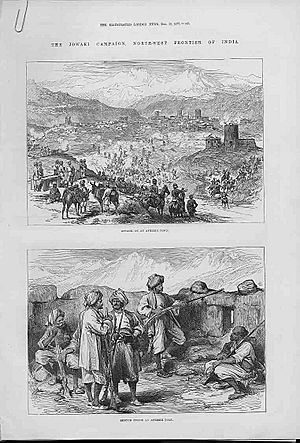Jowaki Expedition facts for kids
Quick facts for kids Jowaki Expedition |
|||||||
|---|---|---|---|---|---|---|---|
 Illustration for The Illustrated London News |
|||||||
|
|||||||
| Belligerents | |||||||
| Jowaki Afridi tribesmen | |||||||
| Commanders and leaders | |||||||
| Brig. Gen. Charles Patton Keyes Brig. Gen. Campbell Claye Grant Ross |
Babar Afridi(Mohammad Shah) | ||||||
| Units involved | |||||||
| Punjab Irregular Force | None | ||||||
| Strength | |||||||
| 7,400 | Unknown | ||||||
| Casualties and losses | |||||||
| 11 killed 51 wounded |
Unknown | ||||||
The Jowaki Expedition was a military action by the British in India. It happened between 1877 and 1878. This expedition began because the British government wanted to pay less money to the Jowaki Afridi tribe. This tribe lived in an area called the Northwest Frontier. The Jowaki tribe was paid to protect a mountain pass called the Kohat Pass. When their payment was cut, they got angry. They attacked British lands in return. The fighting stopped in January 1878 as things calmed down.
Why the Jowaki Expedition Happened
In the 1870s, the British government in India, known as the British Raj, paid the Jowaki Afridi tribe. This payment was to guard the Kohat Pass. At that time, the Jowaki were a very strong Pathan tribe. They lived in the northwest frontier region.
In 1875, local tribes, including the Jowaki, did not like a road being built. This road was planned to go through the Kohat Pass. The Jowaki tribe became very upset in 1877. This was when the British government decided to reduce their payment.
In response, the Jowaki tribe cut a telegraph wire. They also went into a village called Shakkote. There, they killed almost all of the 18 Sepoy guards. They also stole British rifles. On the same day, the British government declared war on the Jowaki. They said the Jowaki must hand over the killers from Shakkote. They also demanded the return of the stolen rifles. Plus, the Jowaki had to pay 30,000 rupees. This payment was to promise good behavior in the future. The Jowaki tribe refused these terms. They said they were ready to fight.
The Expedition's Course
In 1877, the first British attack against the Jowaki began. It included 1,500 troops from the British Punjab Frontier Force. These troops were in three groups. They were led by Frederic David Mocatta. Soon after, a larger force joined them. This force had 5,900 troops in two groups. These groups were led by brigadier generals Charles Patton Keyes and Campbell Claye Grant Ross.
On November 9, the 3rd Sikh Infantry moved into the Paiya Valley. They faced little resistance from the Jowaki. After some small fights, they moved to the Shindai Valley. They pushed back a Jowaki force there. By December 1, they had forced the Jowaki out of their strong base in Jummu. They chased them through the Naru Khula gorge.
In January 1878, the 3rd Sikh Infantry returned to Jummu. Later that month, 50 Jowaki tribesmen met with British leaders. This meeting was in the Paiah Valley for peace talks. However, the Jowaki did not agree to the British terms. They continued to make small, surprise attacks. These attacks included burning the disputed road in Kohat Pass. Even though a peace agreement was never made, the Jowaki Expedition ended.

